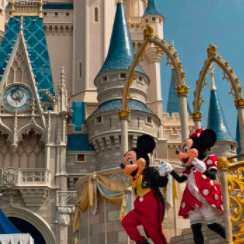For six months, Disney has kept tens of thousands of theme park workers on furlough with full health-care benefits in hopes that a light at the end of the pandemic tunnel would appear. On Tuesday, Disney conceded that none was coming.
The company’s theme park division said it would eliminate 28,000 jobs in the United States. Theme parks will account for most of the layoffs, although Disney Cruise Line and Disney’s retail stores will also be affected.
“As heartbreaking as it is to take this action, this is the only feasible option we have in light of the prolonged impact of Covid-19 on our business, including limited capacity due to physical distancing requirements and the continued uncertainty regarding the duration of the pandemic,” Josh D’Amaro, chairman of Disney Parks, Experiences and Products, said in an email to “cast members,” Disney’s term for its theme park workers.
About 67 percent of the layoffs will involve part-time jobs that pay by the hour. However, executives and salaried workers will also be among those laid off. Disney’s theme parks in California and Florida employed roughly 110,000 people before the pandemic. The job cuts will come from both resorts.
Disneyland in California has remained closed because Gov. Gavin Newsom has not allowed theme parks in the state to restart operations. About 32,000 people work at the Disneyland complex and the majority are unionized and have been on furlough since April.
Mr. D’Amaro said in a statement that the layoffs were “exacerbated in California by the state’s unwillingness to lift restrictions that would allow Disneyland to reopen.” Disney held a virtual news conference on Sept. 22 in an attempt to pressure Mr. Newsom to lift restrictions. “The longer we wait, the more devastation to the Orange County and Anaheim communities,” Mr. D’Amaro said then. “It’s time.”
In a statement on Tuesday evening, Dr. Mark Ghaly, secretary of the California Health and Human Services Agency, said: “Without a vaccine it is impossible to eliminate the economic impacts caused by this virus.” By taking a “science-based approach” to reopening, he continued, “we can minimize the health and economic risks that would be caused by opening and shutting repeatedly.”
In Florida, where government officials have been much less restrictive, Walt Disney World reopened on a limited basis in mid-July. About 20,000 union workers, or roughly half of the resort’s unionized employees, were called back for the reopening. The remainder have stayed on furlough. (Disney World employed about 77,000 people in total before the pandemic.)
But attendance at Disney World has been weaker than Disney expected. In particular, families have not felt safe flying to Florida for vacation, according to travel agents. Families are also delaying visits because they don’t want to pay for Disney excursions when the experience remains limited — no fireworks, fewer dining options, no hugs from Mickey Mouse, shorter park hours — and they have to wear face masks.
Ver esta publicación en InstagramUna publicación compartida por Bugle Miami (@buglemiami) el 30 de Sep de 2020 a las 10:33 PDT


